Discover 35 hidden attractions, cool sights, and unusual things to do in Ho Chi Minh City (Vietnam). Don't miss out on these must-see attractions: Independence Palace, War Remnants Museum, and Notre-Dame Cathedral Basilica of Saigon. Also, be sure to include Ben Thanh Market in your itinerary.
Below, you can find the list of the most amazing places you should visit in Ho Chi Minh City (Hồ Chí Minh).
Table of Contents
Independence Palace
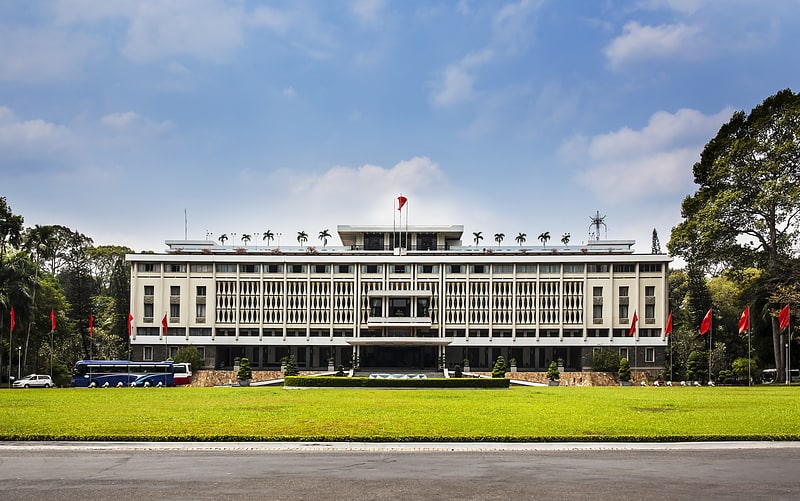
Also known as: Dinh Độc Lập
Prominent government center during war. Independence Palace, also publicly known as Reunification Convention Hall, is a landmark in Ho Chi Minh City, Vietnam. It was designed by architect Ngô Viết Thụ and was the home and workplace of the President of Republic of Vietnam. It was the site of the Fall of Saigon on 30 April 1975 that ended the Vietnam War, when a North Vietnamese Army tank crashed through its gates.[1]
Address: Ho Chi Minh City, 135 Nam Ky Khoi Nghia Street, District 1, Ho Chi Minh City, Vietnam
War Remnants Museum
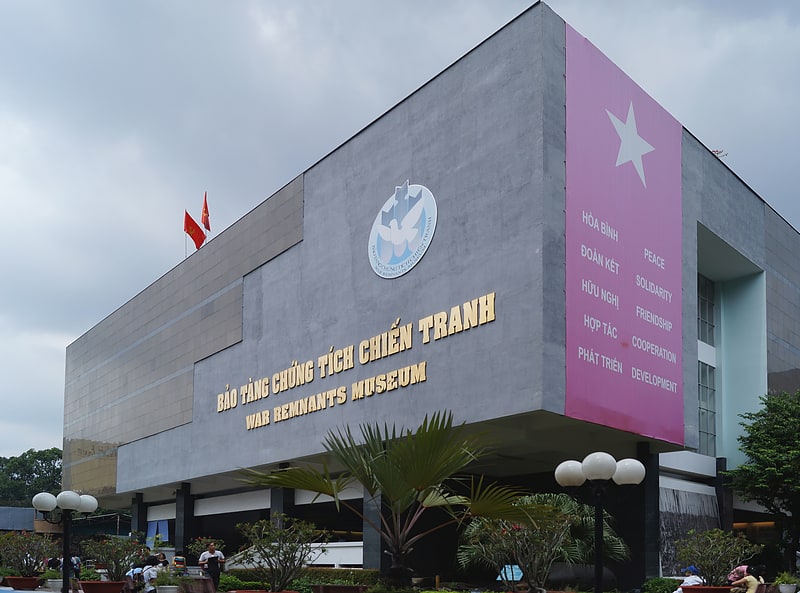
Also known as: Bảo tàng Chứng tích chiến tranh
Military equipment and photos on display. The War Remnants Museum is a war museum at 28 Vo Van Tan, in District 3, Ho Chi Minh City, Vietnam. It contains exhibits relating to the First Indochina War and the Vietnam War.[2]
Address: 28 Võ Văn Tần, 700000 Quận 3 (Quận 3)
Notre-Dame Cathedral Basilica of Saigon
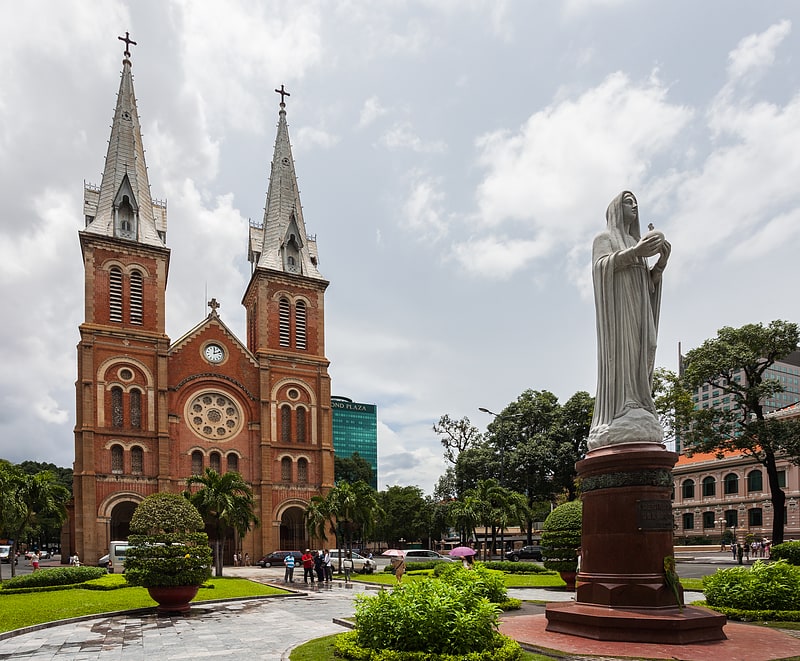
Also known as: Nhà thờ chính tòa Đức Bà Sài Gòn
19th-century European-style cathedral. Notre-Dame Cathedral Basilica of Saigon, officially Cathedral Basilica of Our Lady of The Immaculate Conception is a cathedral located in the downtown of Ho Chi Minh City, Vietnam. Established by French colonists who initially named it the Church of Saigon, the cathedral was constructed between 1863 and 1880. The name Notre-Dame Cathedral has been used since 1959. It has two bell towers, reaching a height of 58 meters.[3]
Address: 01 Công xã Paris, Ho Chi Minh City (Quận 1)
Ben Thanh Market

Also known as: Chợ Bến Thành
Destination for souvenirs and local food. Bến Thành Market is located in the center of Hồ Chí Minh City, Vietnam in District 1. The market is one of the earliest surviving structures in Saigon and an important symbol of the city. Ben Thanh Market is a famous destination for many local and foreign tourists from all around the world. The market operates all year round and opens at around 6am every day until the official closing time at 6pm. After 6pm, the day market transitions into a night market which runs until 10pm.
Today, Ben Thanh Market welcomes more than 10,000 visitors per day to shop and visit. The market has nearly 1,500 booths with more than 6,000 small businesses selling wholesale and retail items from consumables to luxury goods. Currency exchanges are not required by some vendors but most prefer Vietnam's currency, Vietnamese dong.[4]
Address: 36-34-32-30 Phan Bội Châu, Ho Chi Minh City (Quận 1)
Saigon Zoo and Botanical Gardens
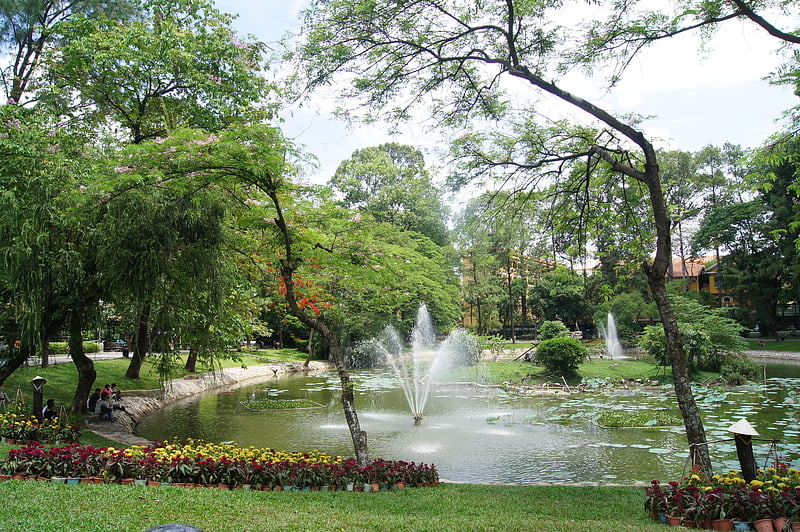
Also known as: Thảo Cầm Viên Sài Gòn
Simple zoo with mammals and reptiles. The Saigon Zoo and Botanical Gardens, established in 1864, is Vietnam's largest zoo and botanical garden. Located on Nguyen Binh Khiem Street in District 1, Ho Chi Minh City, it is home to over a hundred species of mammals, reptiles and birds, as well as many rare orchids and ornamental plants. Also within the grounds is the Museum of Vietnamese History, housing some 25,000 artifacts of history, culture and ethnography of South Vietnam. The grounds also include a temple to the Hung Kings. Other parts of the zoo are divided into animal and plant conservation areas, an orchid garden, and an amusement park.[5]
Address: 2 Nguyen Binh Khiem St, 700000 Ho Chi Minh City (Quận 1)
Saigon Opera House
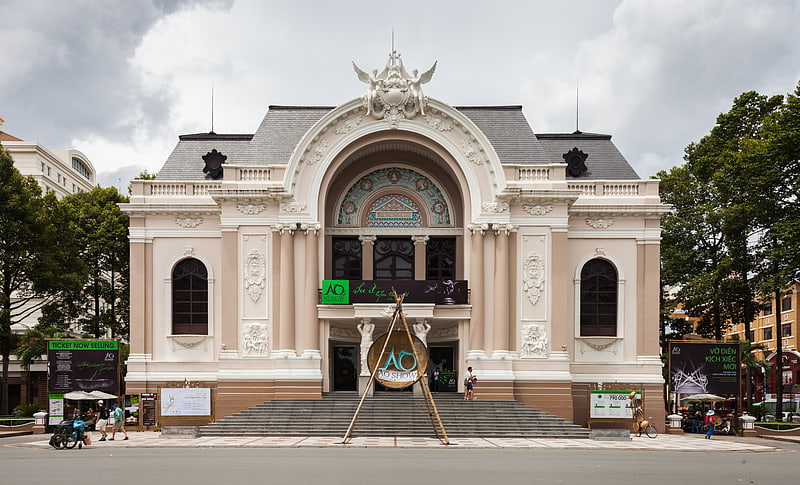
Also known as: Nhà hát Thành phố Hồ Chí Minh
Colonial concert hall and ballet stage. The Municipal Theatre of Ho Chi Minh City, also known as Saigon Municipal Opera House, is an opera house in Ho Chi Minh City, Vietnam. It is an example of French Colonial architecture in Vietnam.
Built in 1897 by French architect Eugène Ferret as the Opéra de Saïgon, the 500 seat building was served as the house of the unicameral National Assembly from 1956 to 1967 and then as bicameral houses: Lower House (Hạ Nghị Viện) and a Senate or Upper House (Thượng Nghị Viện) of the National Assembly of South Vietnam after 1956. And also held the People's Assembly (Đại hội đại biểu Nhân dân) of the Republic of South Vietnam from 1975. It was not until 1976 that it was again used as a theatre, and the façade was restored in 1995.[6]
Address: Ho Chi Minh City, 7 Lam Sơn Square, Bến Nghé Ward, District 1
Ho Chi Minh City Museum

Also known as: Bảo tàng Thành phố Hồ Chí Minh
Regal museum with historic antiquities. Gia Long Palace, now officially the Ho Chi Minh City Museum is a historical site and museum in Ho Chi Minh City/Saigon, Vietnam. The museum is situated at the corner of Lý Tự Trọng and Nam Kỳ Khởi Nghĩa streets, located on 2 hectares of land, near the Independence Palace.[7]
Address: 65 Ly Tu Trong, Ben Nghe ward, District 1, 70000 Ho Chi Minh City (Quận 1)
Công xã Paris Square
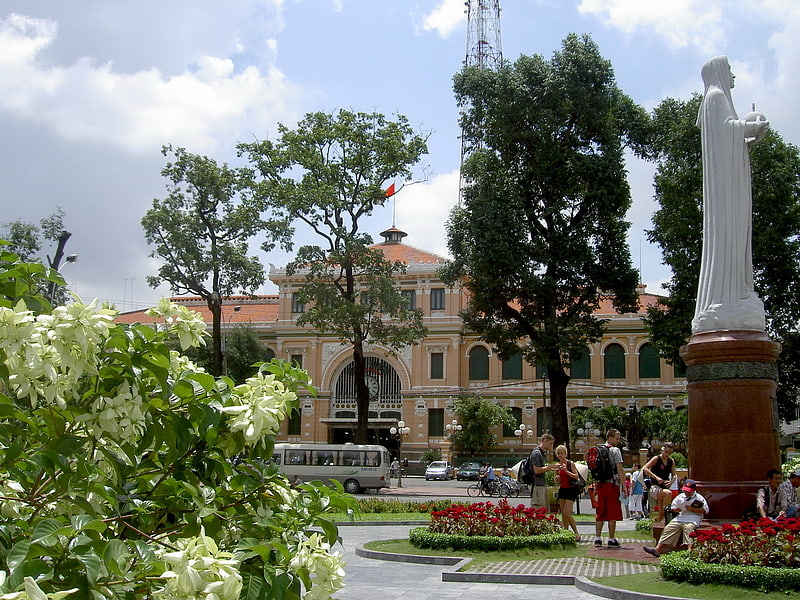
Công xã Paris Square is a small square located in central Ho Chi Minh City, Vietnam in District 1, lies between Notre-Dame Cathedral Basilica of Saigon and Nguyen Du Street. This is also the starting point of the famous Dong Khoi Street. The square is surrounded by two remarkable architectural works: Notre-Dame Cathedral and Central Post Office.[8]
Saigon Central Post Office
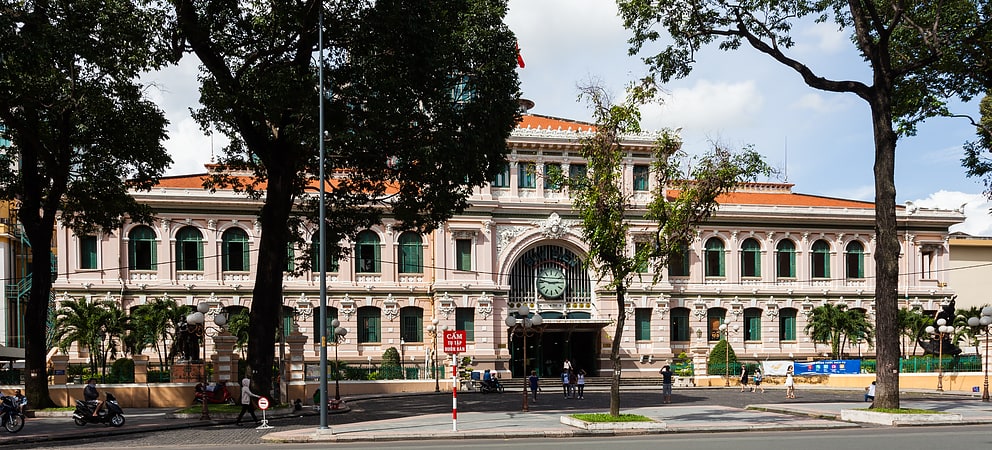
Also known as: Bưu điện trung tâm Sài Gòn
Grand 19th-century post office. The Ho Chi Minh City Post Office, or the Saigon Central Post Office, is a post office in the downtown Ho Chi Minh City, near Saigon Notre-Dame Basilica, the city's cathedral. The building was constructed when Vietnam was part of French Indochina in the late 19th century. It counts with Gothic, Renaissance and French influences. It was constructed between 1886 and 1891 and is now a tourist attraction.
It was designed by Alfred Foulhoux, but is often erroneously credited as being the work of Gustave Eiffel or a collaboration between Foulhoux and Hanoi-based Auguste Henri Vildieu. As translated by the historian Tim Doling, the journal Architecte constructeur: Revue du monde architectural et artistique of 15 September 1891 commented: “The inauguration the new Saigon Post Office, which was held on July 14, had been postponed until the return of the Governor General. This monument, adorned with a most artistic façade, is particularly well laid out and well equipped for the different services to which it is intended; it does the greatest honour to the skill and talent of the distinguished Chief Architect of the Colony, M. Foulhoux.”
Inside the Saigon Central Post office of special note are two painted maps that were created just after the post office was built, the first one located on the left side of the building is a map of Southern Vietnam and Cambodia titled Lignes telegraphiques du Sud Vietnam et Cambodge 1892 ("Telegraphic lines of Southern Vietnam and Cambodia 1892"). The second map of greater Saigon is titled Saigon et ses environs 1892 ("Saigon and its surroundings 1892").
Dương Văn Ngộ, known for being the last public letter writer in Vietnam, worked at the office from 1990 to 2021.[9]
Address: At the top of Dong Khoi St opposite Notre Dame Cathedral, 70000 Ho Chi Minh City (Quận 1)
Tomb of Lê Văn Duyệt
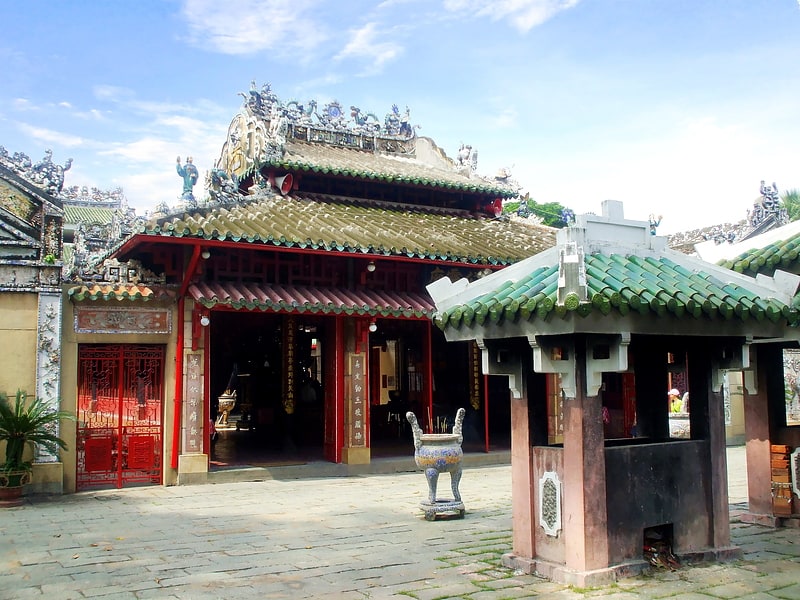
Also known as: Lăng Ông
Tomb of Lê Văn Duyệt, also known as Tomb of the Marshal in Ba Chieu is a Vietnamese tomb located in Bình Thạnh District, Ho Chi Minh City, Vietnam. The tomb was originally built for Marshal Lê Văn Duyệt and his wife but later became some other Nguyễn Dynasty's mandarins worship house.[10]
Address: Phan Đăng Lưu, Ho Chi Minh City (Quận Bình Thạnh)
Chùa Bà Thiên Hậu

Chinese-style temple built in 1760. The Thien Hau Temple, officially the Ba Thien Hau Pagoda, is a Chinese-style temple of the Chinese Goddess of Sea, Mazu on Nguyễn Trãi Street in the Cho Lon of District 5 in Ho Chi Minh City, Vietnam.[11]
Address: 710 Đường Nguyễn Trãi Q5, Ho Chi Minh City (Quận 5)
Giác Lâm Pagoda
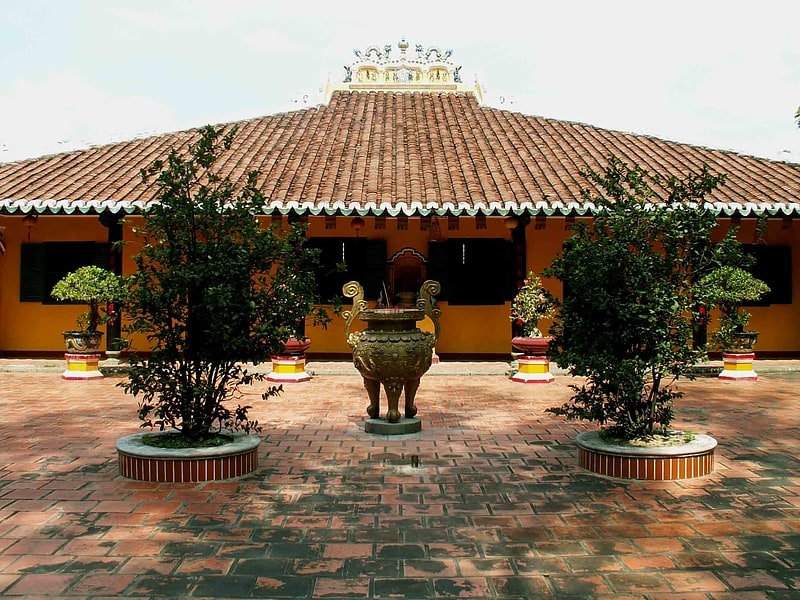
Also known as: Chùa Giác Lâm
Buddhist temple in Ho Chi Minh City, Vietnam. Giác Lâm Pagoda is a historic Buddhist pagoda in Ho Chi Minh City, the largest city in Vietnam. Built in 1744, it is one of the oldest temples in the city. It was officially listed as a historical site by the Vietnamese Department of Culture on November 16, 1988 under Decision 1288 VH/QD. The pagoda is located at 118 Lạc Long Quân, in the 23rd ward of Tân Bình district, in the Phú Thọ Hòa region of the city. It stands on Cẩm Sơn, and is also known as Cẩm Đệm and Sơn Can.[12]
Address: 118 Lạc Long Quân, Ho Chi Minh City (Quận Tân Bình)
Bảo Tàng Mỹ Thuat

Also known as: Bảo tàng Mỹ thuật Thành phố Hồ Chí Minh
Museum in Ho Chi Minh City, Vietnam. Ho Chi Minh City Museum of Fine Arts is the major art museum of HCM City, Vietnam, and second in the country only to the Vietnam National Museum of Fine Arts in Hanoi.
The museum covers three three-floor buildings which house a collection featuring Vietnamese art works in sculpture, oil, silk painting and lacquer painting, as well as traditional styles including woodcut paintings in the Hàng Trống, Đông Hồ, and Kim Hoàng styles, as well as Vietnamese ceramics and a collection of ancient Buddhist art. The first floor also includes a commercial gallery of art works. Archaeological exhibits such as some of the country's best Champa and Óc Eo relics are displayed on the third floor.
The main building was constructed by a French architect Rivera between 1929 and 1934 as a villa for the Hua (Hui-Bon-Hoa) family. The museum moved there in 1987.[13]
Address: 97A D Pho Duc Chinh, 70000 Ho Chi Minh City (Quận 1)
Bitexco Financial Tower
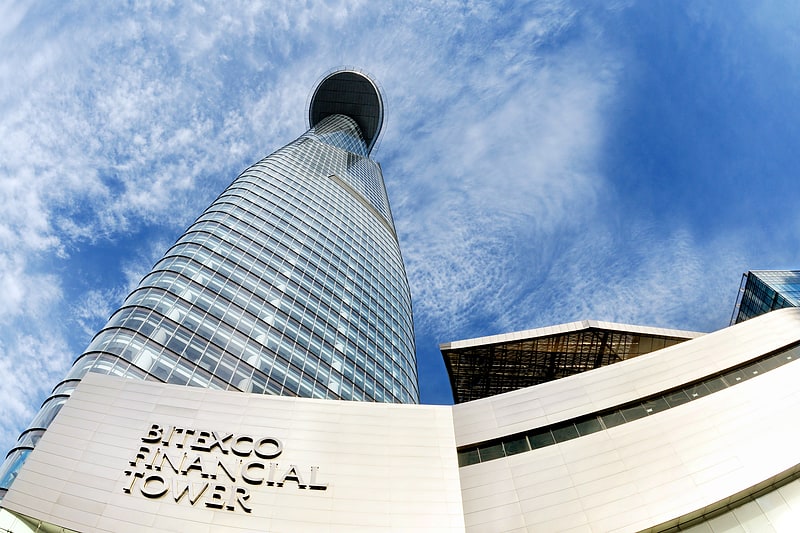
Also known as: Tòa nhà Bitexco Financial
Skyscraper with a mall and a viewing deck. Bitexco Financial Tower is a skyscraper in Ho Chi Minh City, Vietnam. At its completion in 2010, it became the tallest building in Vietnam and kept this status until January 2011, when it was surpassed by Keangnam Hanoi Landmark Tower. With 68 floors above ground and three basements, the building has a height of 262.5 metres, making it the second tallest building in the city, fifth tallest in Vietnam, and the 263rd tallest in the world, as of the beginning of 2018.
The tower is owned by Bitexco Group, a Vietnamese multi-industry corporation, with a focus on real estate development. The building also houses the Ho Chi Minh City office of Bitexco Group, while its headquarters are in Hanoi.
The tower was designed by Carlos Zapata, Design Principal and Founder of Carlos Zapata Studio, with French company AREP as architect of record. Designer Zapata, who was born in Venezuela but is based in New York City, drew inspiration for this skyscraper's unique shape from Vietnam's national flower, the Lotus.
The tower was officially inaugurated on 31 October 2010. In 2013, CNN.com named the Bitexco Financial Tower one of the 25 Great Skyscraper Icons of Construction. And in 2015, Thrillist.com named the Bitexco Financial Tower the #2 Coolest Skyscraper in the World.[14]
Address: 36 Ho Tung Mau Street, Ben Nghe ward, District 1, 70000 Ho Chi Minh City (Quận 1)
Jade Emperor Pagoda
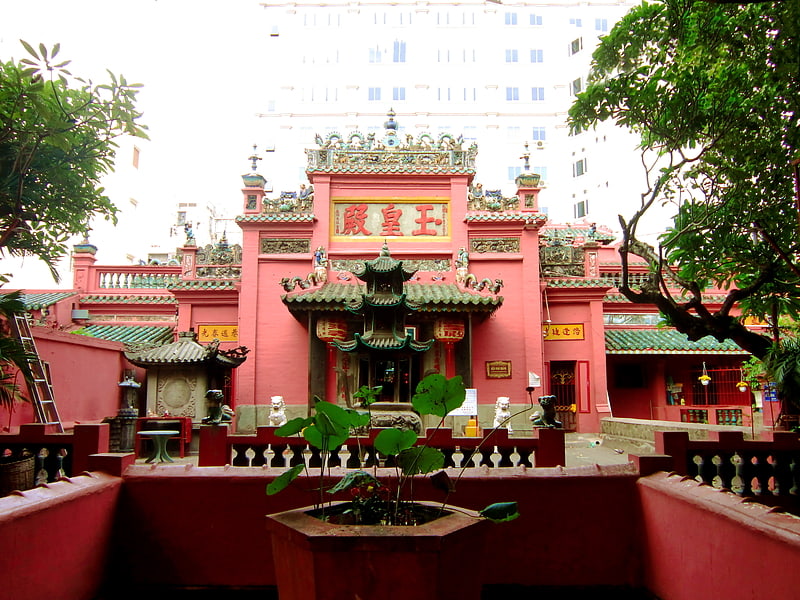
Also known as: Chùa Ngọc Hoàng
Bustling temple with a tortoise pond. The Jade Emperor Pagoda also known as the Tortoise Pagoda is a Taoist pagoda located at 73 Mai Thi Luu Street, District 1, Ho Chi Minh City, Vietnam. It was founded by Lưu Minh or Liu Taoyuan, a Cantonese, China. It is also known from 1984 by the new name and as the Tortoise Pagoda. Then U.S. President Barack Obama paid a visit to the pagoda during his state trip to Vietnam on 22 May 2016.[15]
Address: 73 Mai Thi Luu, 700000 Ho Chi Minh City (Quận 1)
Xá Lợi Pagoda
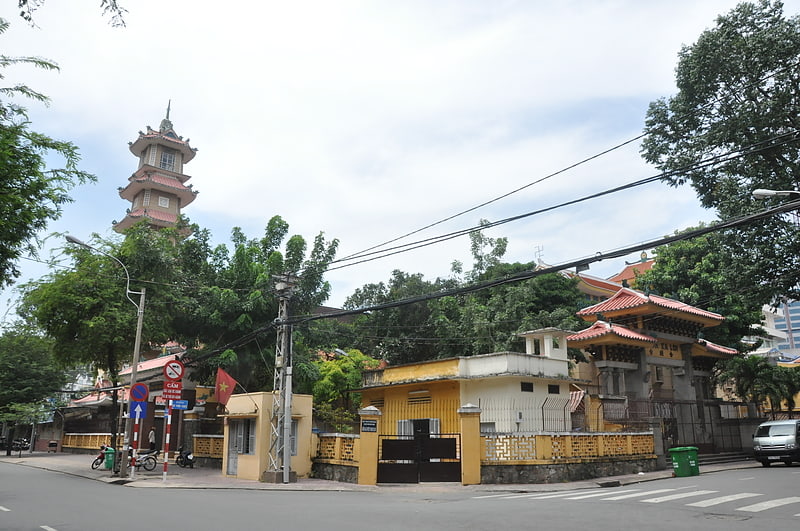
Also known as: Chùa Xá Lợi
Buddhist pagoda with a unique history. The Xá Lợi Pagoda is the largest pagoda in Hồ Chí Minh City, Vietnam. It was built in 1956 and was the headquarters of Buddhism in South Vietnam. The pagoda is located in District 3, Hồ Chí Minh City and lies on a plot of 2500 square metres. The name Xá Lợi is the Vietnamese translation for śarīra, a term used for relics of Buddhists.
The pagoda was best known for the raids, in which the Army of the Republic of Vietnam Special Forces loyal to Ngô Đình Nhu, the brother of the Roman Catholic President Ngô Đình Diệm, raided and vandalised Buddhist monasteries and pagodas on 21 August 1963.[16]
Address: 89 Ba Huyen Thanh Quan St, District 3, Ho Chi Minh City (Quận 3)
Tân Định Church
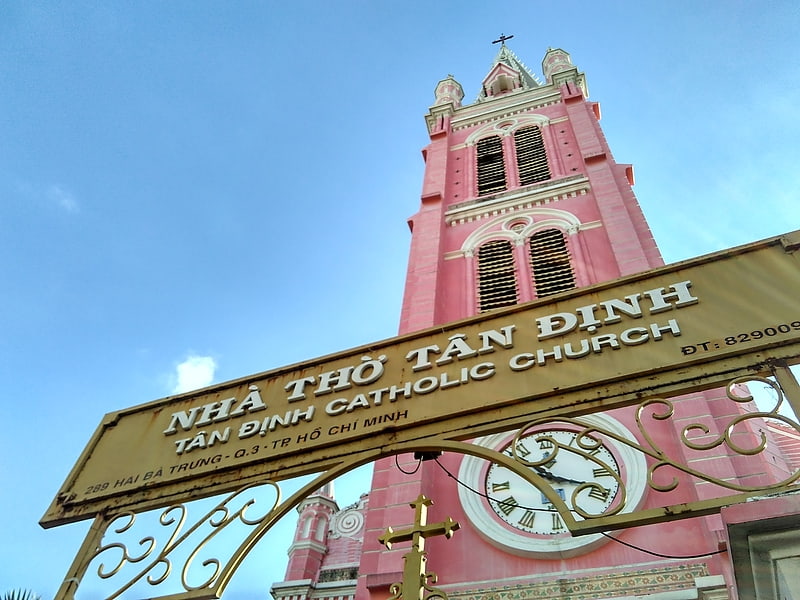
Also known as: Nhà thờ Tân Định
Catholic church with a pink facade. Tân Định church is a Roman Catholic church in Ho Chi Minh City, Vietnam. Its formal name is the Church of the Sacred Heart of Jesus. Even though it is in District 3, the parish shares its name with neighbouring District 1's Tân Định Ward.
It was built during the French colonial period in the 1870s and completed on 16 December 1876, when Vietnam was part of French Indochina. The architecture is mainly neo-Romanesque, but it also has some neo-Gothic and neo-Renaissance elements. It has been painted pastel-pink both on the exterior and interior since 1957, earning it the nickname "the pink church" (nhà thờ màu hồng).
It is the second-largest church in Ho Chi Minh City, after Notre-Dame Basilica in District 1. They both belong to the Archdiocese of Ho Chi Minh City. Tân Định Church is not a cathedral; Notre-Dame is the cathedral (seat) of this metropolitan archdiocese.
Its address is 289 Hai Bà Trưng Street, Ward 8 (Phường 8), District 3, Ho Chi Minh City.[17]
Address: 289 Hai Ba Trung, Ward 8, District 3, 70000 Ho Chi Minh City (Quận 3)
Vạn Hạnh Zen Temple
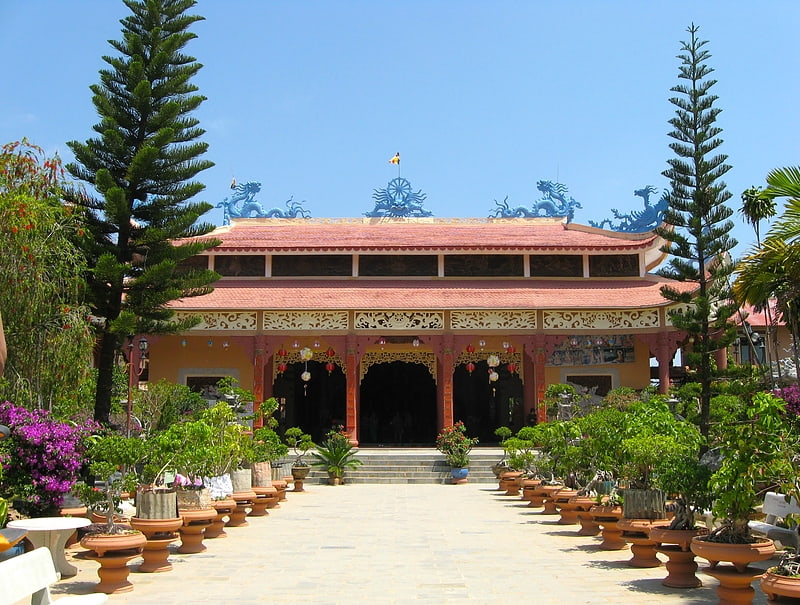
Vạn Hạnh Zen Temple is a Zen Buddhist temple in Ho Chi Minh City, the largest city in Vietnam. The temple is located at 716 Nguyễn Kiệm Street on the road between Go Vap and Phu Nhuan districts. It is the location of the main Buddhist training centre for sangha in Vietnam, and is also the office of the Vietnamese Buddhist Research Institute.
Before the fall of Saigon in 1975, the site of the temple was the campus of the school of applied science of Vạn Hạnh Buddhist University, under the leadership of Thích Minh Châu. In 1976, with the reunification of Vietnam. It was converted into a Zen meditation temple and Buddhist research centre.
The temple is located on a block of land of one hectare in size. It comprises a main ceremonial hall, a patriarch hall, living and dining quarters for the sangha and separate facilities for various educational institutions. These include the office of the Vietnamese Buddhist Research Institute, the office of the Society for the Translation of the Mahayana sutras and the main Buddhist training centre in Vietnam, which trains Buddhist sangha.
The temple fate was built in 1990 along the architectural model of the Buddhist temples in the central city of Huế, under the administration of Thích Tâm Đoan and Thích Tịnh Quang. The main hall is two-storied. The ground storey is the main ceremonial hall, with a white statue of Gautama Buddha seated on a lotus in the centre of the hall. One either side of the main hall are reading rooms of the temple's library, which stocks a large range of religious documents. The upper storey contains the guest room and the office of the abbot.
The patriarch hall of the temple is also two-storied. The upper storey is for paying homage to the Buddha and to the patriarchs. On the altar of the patriarch altar is Thích Tịnh Khiết, the first head of the United Buddhist Congregation of Vietnam. The ground floor serves as the dharma hall, where dharma talks are held.
Vạn Hạnh Zen Temple is the working office of the Buddhist Research Institute of Vietnam, where a team of Buddhist scholars works under Thích Minh Châu, who holds a doctorate in Buddhism and psychology. The institute is divided into departments, one for Vietnamese Buddhism, world Buddhism and one for printing and distribution. Another team is devoted towards translating Mahayana scriptures from Chinese into Vietnamese, in addition to the translation of the Pali Canon.
The temple is also a major contributor in the training of Vietnamese Buddhist monks in the south of the country. It is the host of an institute of higher education in Buddhism, at an equivalent level to a university degree. Monks and nuns are accepted through an examination process to start a four-year course. Since 1984, the school has run three courses, training more than 400 members of the sangha.[18]
Quan Âm Pagoda
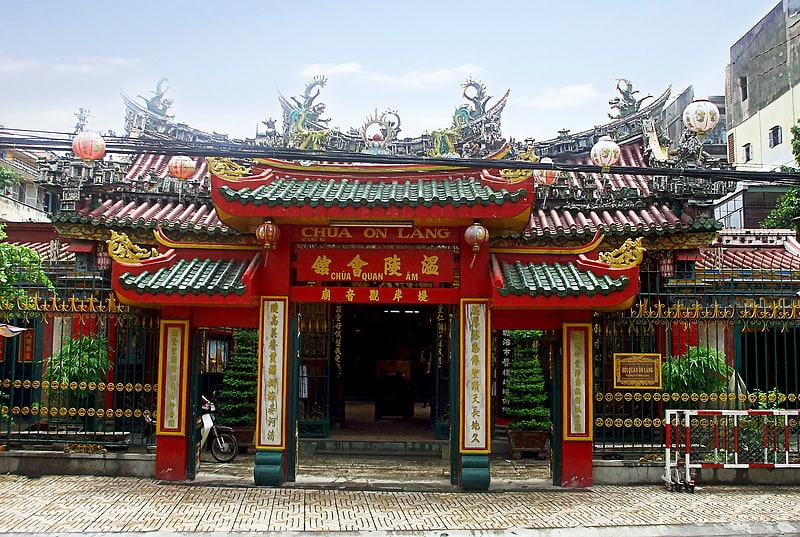
Also known as: Hội quán Ôn Lăng
Buddhist temple in Ho Chi Minh City, Vietnam. Quan Âm Pagoda is a Chinese-style Buddhist pagoda located on Lao Tu Street in Cho Lon, District 5, Ho Chi Minh City, Vietnam. Founded in the 19th century, it is dedicated to Guanyin, the Chinese goddess of mercy and the Chinese form of the Indian bodhisattva Avalokiteshvara. The pagoda is popular among both Vietnamese and Chinese Buddhists; most of its inscriptions are in Chinese characters, but some have had Vietnamese labels added. In addition to veneration of Guanyin and the teachings of the Buddha, the pagoda also includes Pure Land worship of the Amitabha Buddha, elements of Taoism, and the folk worship of the Fujianese sea goddess Mazu in her role as the "Queen of Heaven".[19]
Address: 12 Lão Tử Q5, Ho Chi Minh City (Quận 5)
Bến Nhà Rồng
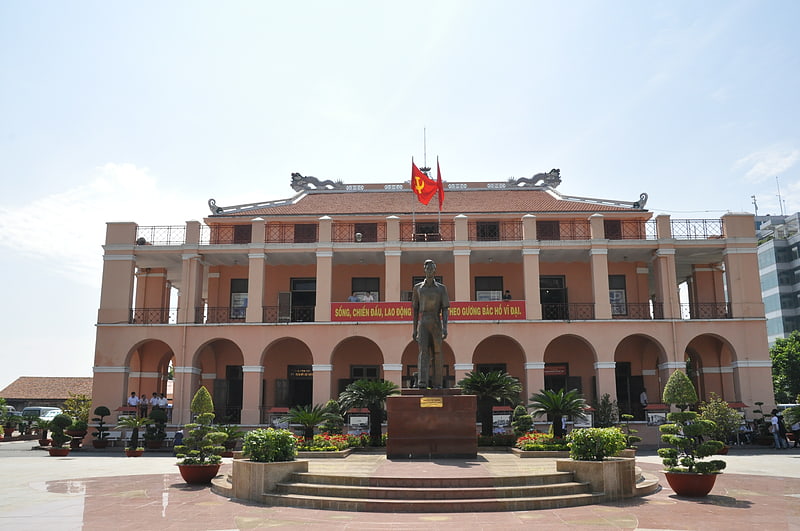
Museum in Ho Chi Minh City, Vietnam. Dragon Wharf or Ho Chi Minh Museum is the original commercial port of Saigon. It is located on the Saigon River. Construction began in 1862 and more than a year later, in 1863, the house was completed. It is located at the junction of the Saigon River in District 4.
On 5 June 1911, Ho Chi Minh (at the time named Nguyen Tat Thanh) departed from the Dragon Wharf on the French ship Amiral de Latouche-Tréville for a 30-year journey around the world. Therefore, in 1979, the old headquarters building of the commercial port has been rebuilt into a memorial park in Ho Chi Minh City.
During the Vietnam War the building was used by the United States Military Sea Transportation Service.[20]
Address: 1 Nguyễn Tất Thành, P. 12, Quận 4, Ho Chi Minh City (Quận 4)
Cầu Thủ Thiêm
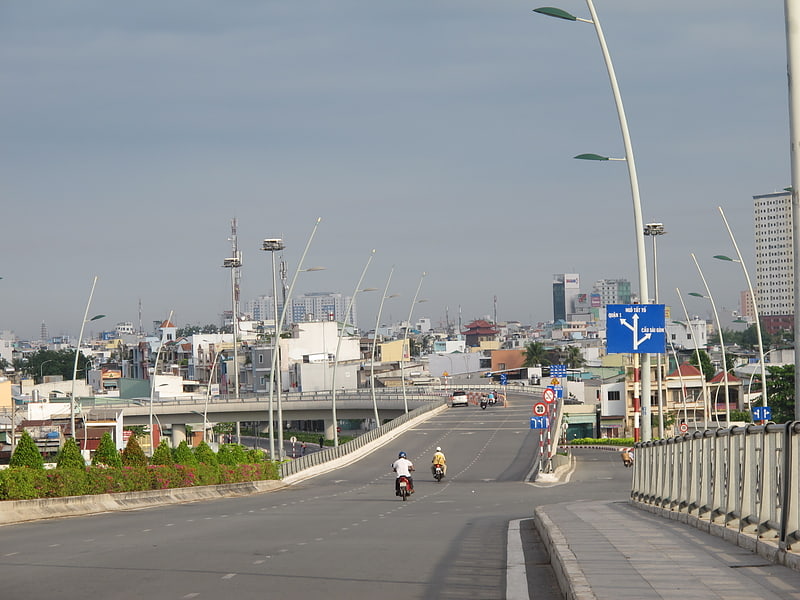
Bridge in Ho Chi Minh City, Vietnam. Thủ Thiêm Bridge is a 6-lane bridge in Ho Chi Minh City, the largest city of Vietnam, opened in 2008. The bridge links District 2 with Bình Thạnh District, near downtown District 1. This bridge is an important link between existing downtown of Ho Chi Minh City with Thu Thiem New Urban Area. The cost estimate for construction of the bridge was US$60 million, implemented by a consortium of Vietnamese contractors. The progress was delayed due to delay in land compensation – a big problem in project management faced by many investors in Vietnam.[21]
Address: Cầu Thủ Thiêm, Q2, Ho Chi Minh City (Quận 2)
Saigon Bridge
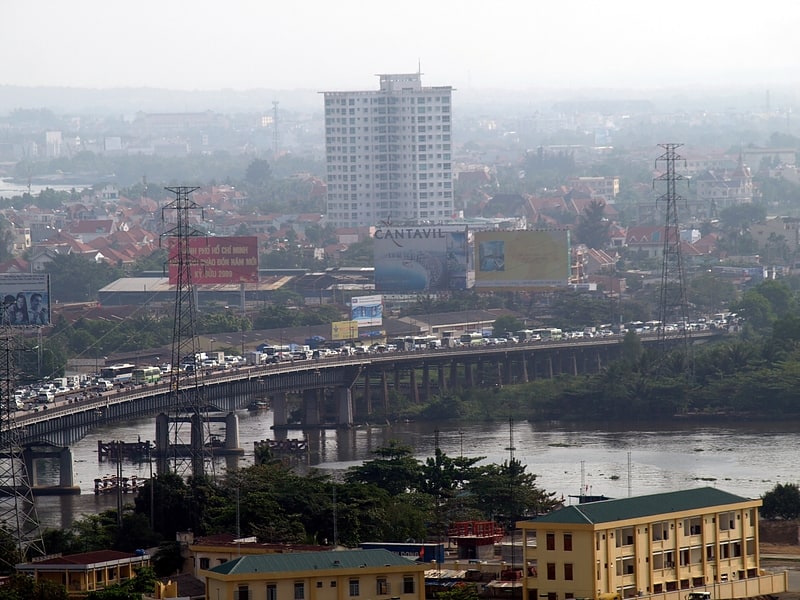
Also known as: Cầu Sài Gòn
Bridge in Ho Chi Minh City, Vietnam. Saigon Bridge, known as Newport Bridge before 1975, is a bridge crossing the Saigon River, connecting Bình Thạnh District and District 2, Ho Chi Minh City, on the Hanoi Highway. The bridge has four lanes for cars and two lanes for motorcycles and bicycles. It was the only bridge linking District 1 to the new Thu Thiem New Urban Area in District 2 until the Thủ Thiêm Bridge opened in 2008 and the Saigon River Tunnel opened in 2011. The bridge was one of the most vital gateways for vehicles traveling from northern and central Vietnam to the city, and therefore was a key point of contention during the Tet Offensive in 1968 and the Fall of Saigon in 1975. In 2013, a new parallel bridge, Saigon 2 Bridge, was opened to ease congestion on the bridge.[22]
Address: 257 Xã Đàn, Ho Chi Minh City (Quận Bình Thạnh)
Khu du lịch Suối Tiên
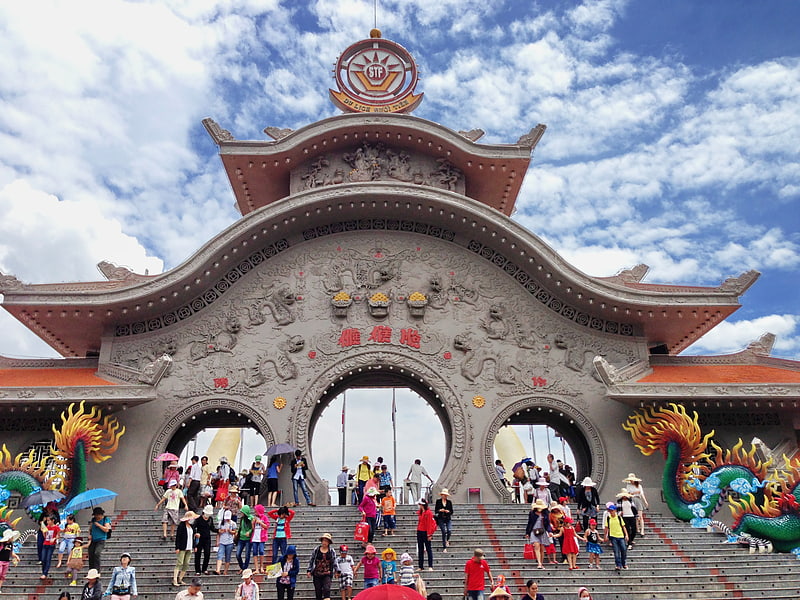
Amusement, Amusement park, Theme park
Address: Quận 9, Ho Chi Minh City (Quận 9)
Bình Quới Tourist Village

The Binh Quoi Tourist Village is a tourist attraction in the Bình Thạnh District of Ho Chi Minh City, in southern Vietnam.
The Tourist Village comprises the two parts of the Bình Quới Tourist Area. The Bình Quới Tourist Area I was established by the Vietnamese government in 1975 and 1976, while the Bình Quới Tourist Area II was built from 1979 to 1980, and the Tourist Village was established in 1994. The Tourist Village is located on the Thanh Da peninsula on the Saigon River approximately 8 km (a 20- to 30-minute drive depending on traffic) from the city center.
The Tourist Village is set on lush garden-like grounds with lawns, coconut trees, creeks, and thatched cottages, presenting a view of days gone by in Vietnam's Mekong Delta region. Rich traditional southern Vietnamese cuisine is served there, and the area features a three-level, 700-seat floating restaurant in Bạch Đằng Harbor.
Entertainment includes a cultural show featuring a traditional Vietnamese wedding, complete with water-borne bridal procession, rituals, and dances.[23]
Saigon Times Square

Building in Ho Chi Minh City, Vietnam. Times Square is a high-rise building in District 1, Ho Chi Minh City, Vietnam. This tower is a 40-storey joint tower and features a modern architectural style. Construction costs, invested by Times Square Investment Joint Stock Company, totals approximately US$125 million. The height to the top of the tower is 164 m. The tower was once the third tallest building in Ho Chi Minh City after Saigon One Tower and Bitexco Financial Tower. Currently, Saigon Times Square ranks sixth in height in the city and 23rd nationally.
Times Square hosts The Reverie Saigon, a 286-room Leading Hotels of the World-owned luxury hotel, along with 89 service apartments and 11,900 sq meters of office space.[24]
Address: 22-36 Nguyễn Huệ, Ho Chi Minh City (Quận 1)
Phú Mỹ Bridge
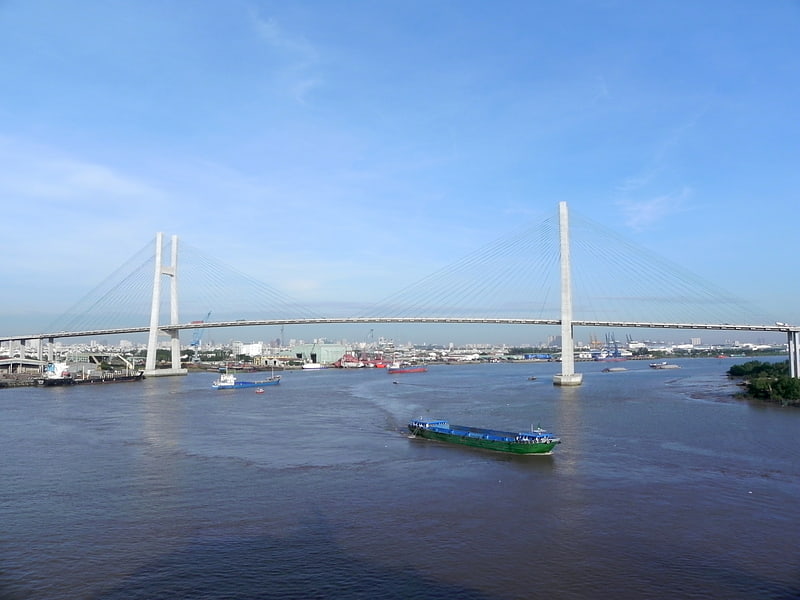
Also known as: Cầu Phú Mỹ
Cable-stayed bridge. The Phú Mỹ Bridge is a cable-stayed road bridge over the Saigon River in Ho Chi Minh City, Vietnam.
The bridge was constructed from March 2007 to September 2009 by a consortium consisting of Baulderstone, Bilfinger Berger, Freyssinet (cable stays and stressing), and the Vietnamese company CC620 (concrete, formwork, etc.) and was designed by the French consultant Arcadis (design of the main bridge) and Cardno (design of the approaches). The project manager for the project was AECOM.
The Phu My Bridge is 705 metres long across the river, with a main span of 380 metres and the approach viaduct structures on either side of the river are approximately 758m and 638m long respectively. The modified H-shaped main towers, which are 145m high, support a 27m wide main span deck. It has six lanes of traffic; two lanes of vehicle traffic in each direction, and a separate lane for motorbikes and pedestrian footways. The bridge will connect District 2 on the north side of the river to District 7 and forms part of a new ring road currently being built around the south and east of Ho Chi Minh City.
The bridge was officially opened to traffic in a ceremony attended by the Prime Minister of Vietnam, Nguyễn Tấn Dũng, along with other Vietnamese and Australian government officials, on 2 September 2009.
Phu My Bridge Corporation (PMC) has a thirty-year BOT licence to operate the bridge which will be part of a toll road. PMC is a private consortium comprising Hanoi Construction Company, Investco, Cienco 620, Thanh Danh Co, and CII. The project was privately financed by PMC along with export credit guarantees from Germany, France and Australia. As part of the financing arrangements almost half of the contract expenditure must be in these three countries. These three aspects of the project (private sector infrastructure, private sector BOT scheme, and export credit finance) are all firsts for Vietnam.[25]
Ho Chi Minh City Hall
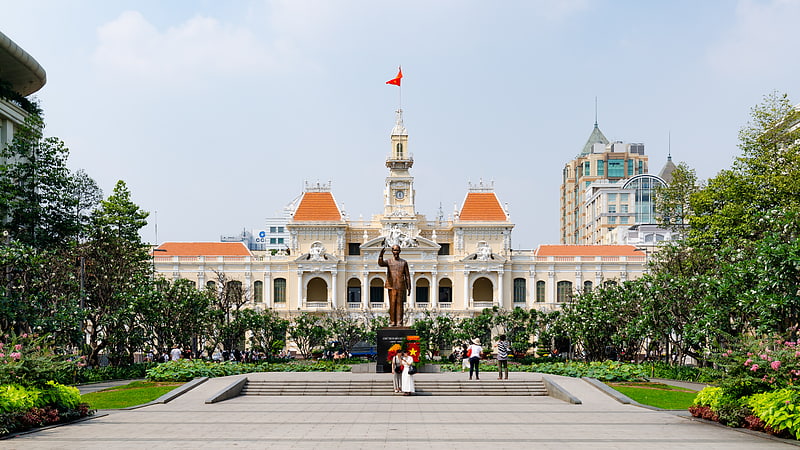
Also known as: Trụ sở Ủy ban nhân dân Thành phố Hồ Chí Minh
French colonial–style city hall. Ho Chi Minh City Hall, officially called the Ho Chi Minh City People's Committee Head Office is the city hall of Ho Chi Minh City, Vietnam.
The hall was built in 1902–1908 in a French colonial style by architect Paul Gardès. Since 1975, the building has housed the Ho Chi Minh City People's Committee, Ho Chi Minh City People's Council and Ho Chi Minh City People's Court.
Although the building is not open to the public, it is popular for its photo opportunities. Tourists can take photographs outside and many people choose to do this at night when the building and its grounds are lit up.
Other buildings nearby:
- Municipal Theatre, Ho Chi Minh City
- HSBC Building, Ho Chi Minh City
- Rex Hotel, Ho Chi Minh City
Address: 86 Lê Thánh Tôn, Ho Chi Minh City (Quận 1)
Bình Triệu Bridge

Also known as: Cầu Bình Triệu
Bridge in Ho Chi Minh City, Vietnam. The Bình Triệu Bridge is a road bridge that crosses the Saigon River in Ho Chi Minh City. The road on the bridge heads out to Thủ Dầu Một.[27]
Việt Nam Quốc Tự
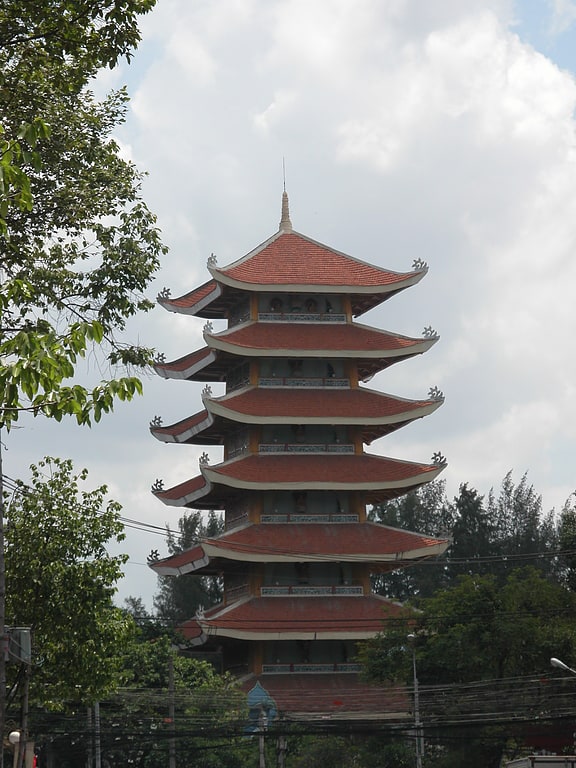
The Việt Nam Quốc Tự is located on February 3rd Blvd. District 10 of Ho Chi Minh City, Vietnam. The pagoda, seven stories tall, is full of colorful, oversized statues of religious figures. On the first and fifteenth of the month, the pagoda opens up its third and seventh floors to the public. On other days, the second floor is accessible; it features a shrine made up of miniature Buddhas floating against a cloudy sky mural.
The pagoda was built in 1963.[28]
Address: 246 Đường 3 Tháng 2, Ho Chi Minh City (Quận 10)
Thuận An
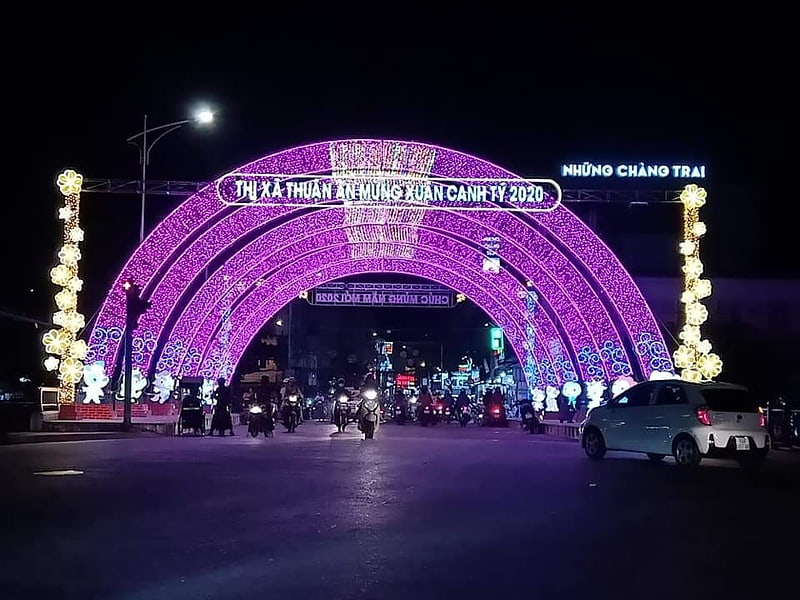
Thuận An is a city of Bình Dương Province in the Southeast region of Vietnam. As of January 1, 2014 the city had a population of 438,922. The town covers an area of 83.7 km². The center of this town - Lái Thiêu - is famous for its ceramic and fruits.[29]
Chùa Hoằng Pháp
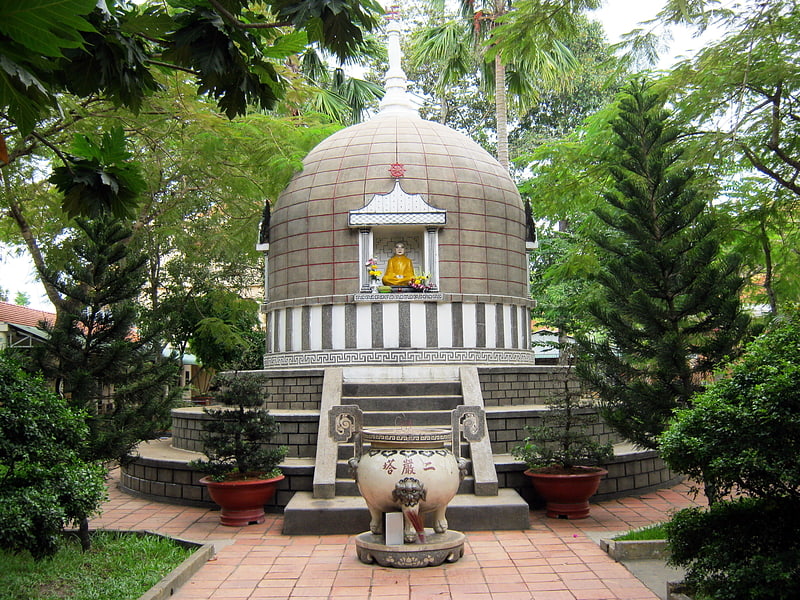
Temple in Ho Chi Minh City, Vietnam. Hoằng Pháp temple is a temple in Hóc Môn, a suburb of Hồ Chí Minh City.[30]
Address: Hóc Môn, Ho Chi Minh City
Deutsches Haus Ho Chi Minh City

The Deutsches Haus Ho Chi Minh City is a building complex in Ho Chi Minh City, Vietnam, which was opened 2017. The 25-story building complex was initiated under a bilateral government agreement between Germany and Vietnam, with the purpose of setting standards for energy efficiency “made in Germany.” It is the location of the German Consulate General and other institutions and businesses, as well as a cultural and economic hub for German representation in Vietnam.[31]
Chùa Vĩnh Nghiêm
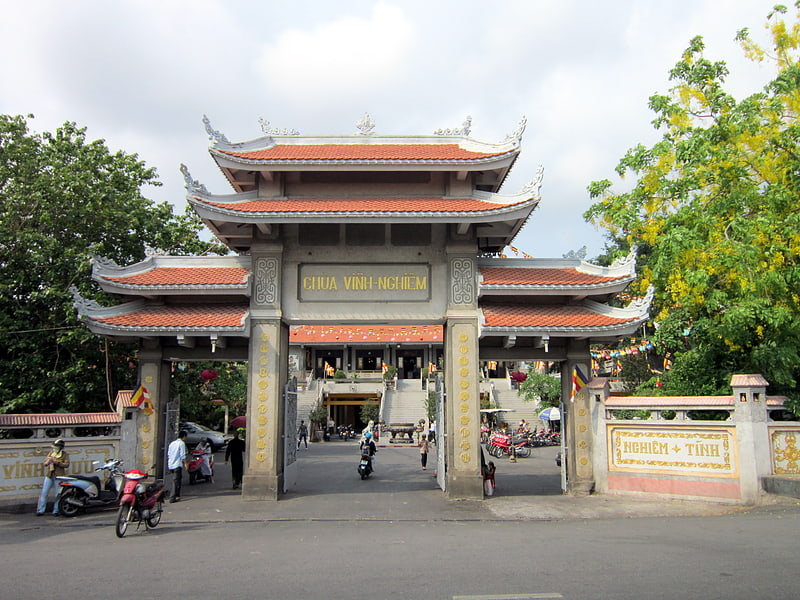
Buddhist temple in Ho Chi Minh City, Vietnam. Vĩnh Nghiêm Pagoda is a pagoda in an area of 6,000 square metres at 339, Nam Kỳ Khởi Nghĩa street, Ward 7, District 3 Ho Chi Minh City. This is the first pagoda in Vietnam to be built in Vietnamese traditional architecture style but with concrete. The highest structure in this pagoda is the 7-story, 40-metre-high tower. This pagoda houses and worship of one buddha and two bodhisattvas: Gautama Buddha, Manjusri, Samantabhadra.[32]
Address: 339 Nam Ky Khoi Nghia, Q.3, 70000 Ho Chi Minh City (Quận 3)
Củ Chi tunnels
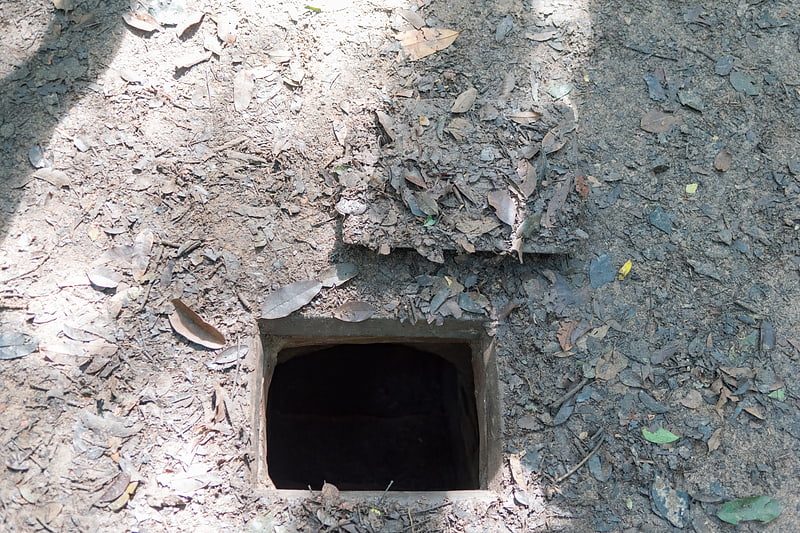
Also known as: Địa đạo Củ Chi
War memorial in Ho Chi Minh City, Vietnam. The tunnels of Củ Chi are an immense network of connecting tunnels located in the Củ Chi District of Ho Chi Minh City, Vietnam, and are part of a much larger network of tunnels that underlie much of the country. The Củ Chi tunnels were the location of several military campaigns during the Vietnam War, and were the Viet Cong's base of operations for the Tết Offensive in 1968.
The tunnels were used by Viet Cong soldiers as hiding spots during combat, as well as serving as communication and supply routes, hospitals, food and weapon caches and living quarters for numerous North Vietnamese fighters. The tunnel systems were of great importance to the Viet Cong in their resistance to American forces, and helped to counter the growing American military effort.[33]
District 5

Vietnamese urban district. District 5 is an urban district of Ho Chi Minh City, the largest city in Vietnam. The Chinese community accounts for a significant population in this district. There are several hospitals, high schools and universities in this district.
As of 2010 the district had a population of 174,154 people. The district covers an area of 4.27 km².
There are 15 wards in District 5, from Ward 1 to Ward 15.[34]